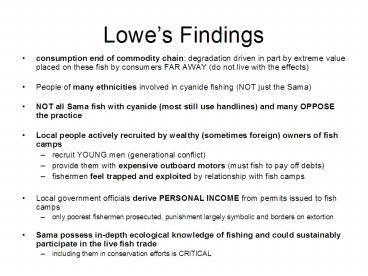Lowes Findings - PowerPoint PPT Presentation
1 / 8
Title:
Lowes Findings
Description:
People of many ethnicities involved in cyanide fishing (NOT just the Sama) NOT all Sama fish with cyanide (most still use handlines) and many OPPOSE the practice ... – PowerPoint PPT presentation
Number of Views:97
Avg rating:3.0/5.0
Title: Lowes Findings
1
Lowes Findings
- consumption end of commodity chain degradation
driven in part by extreme value placed on these
fish by consumers FAR AWAY (do not live with the
effects) - People of many ethnicities involved in cyanide
fishing (NOT just the Sama) - NOT all Sama fish with cyanide (most still use
handlines) and many OPPOSE the practice - Local people actively recruited by wealthy
(sometimes foreign) owners of fish camps - recruit YOUNG men (generational conflict)
- provide them with expensive outboard motors (must
fish to pay off debts) - fishermen feel trapped and exploited by
relationship with fish camps - Local government officials derive PERSONAL INCOME
from permits issued to fish camps - only poorest fishermen prosecuted, punishment
largely symbolic and borders on extortion - Sama possess in-depth ecological knowledge of
fishing and could sustainably participate in the
live fish trade - including them in conservation efforts is CRITICAL
2
Cattle Ranching Deforestation in Latin America
- George Ledec now affiliated with the World Bank
Environmental Unit for Latin America - deforestation the more or less permanent
removal of most of the natural tree cover from an
area - major cause of deforestation in Latin America
CATTLE RANCHING - not all parts of Latin America have natural
grazing lands tropical forests cleared and
fodder grasses planted - requires large amounts of land (not many
opportunities for intensification, must clear
larger sections of land) - yields much smaller economic returns per land
area than other cash crops
3
Social Impacts of Deforestation
- Loss of Wood Production maximizes short-term
profits from cattle over long-term profits from
sustainable timber harvest - Loss of Environmental Services watershed and
soil conservation, hydroelectric power, fisheries
(esp. fruit-eating fish), brazil nut production
(destroys habitat for Euglossine bees that
pollinates these trees) - Loss of Biological Diversity 20 of all plant
species on earth - Climatic Stability rainforest generates 50 of
its own rainfall - Destruction of Livelihoods of Local
Forest-Dwelling Peoples - Replaces Crop Production and Agricultural
Production (reduces fallow, etc.) - Low-Density Settlements (costly to extend
services and infrastructure to these areas)
4
Why raise cattle despite these drawbacks? What is
driving this production system?
- The Hamburger Connection
- i.e. Brazil worlds largest beef exporter
- 70 sold in the European Union
- system driven by demand for beef abroad
- Development Aid Government Policies
- ranchers receive subsidized credit from govt
banks and land taxed at very low rates - clearing land establishes ownership in the eyes
of the government (ranching takes least labor and
effort among ways of exhibiting ownership) - target of development investment from
international organizations - World Bank (1985) Most countries in Latin
America probably have a comparative advantage not
in poultry and in pork but in beef and milk
because of their substantial pastoral
resources. - these policies encourage the conversion of forest
to pasture land - MUST OFFER ALTERNATIVES to these policies to stop
deforestation
5
Environmental Identity Social Movement Thesis
- Changes in environmental management regimes and
environmental conditions have created
opportunities or imperatives for local groups to
secure and represent themselves politically
(Robbins 2004 188). - environmental movements often represent NEW
forms of political action - unite groups across class, ethnicity, and gender
lines - LOCAL social/environmental movements can weaken
otherwise powerful GLOBAL political and economic
forces
6
Kayapo Out of the Forest
- 1989 Brazilian indigenous groups unite to
successfully stop the construction of a
hydroelectric dam - massive demonstration near proposed dam site at
Altamira 600 Kayapo, 40 indigenous nations, 400
news reporters, Sting - Events researched and filmed by anthropologist
Terence Turner (University of Chicago) - Indigenous organizers Chief Ropni his nephew
Poyakan
7
- Kayapo Background
- live along the upper tributaries of the Xingu
River in Brazil - sustained contact with outside world starting in
the late 1950s - 1993 population 4000, living in 14 relatively
remote villages - have semi-autonomous control of land reserves
given to them by the Brazilian govt in 1980s
1990s total 100,000 square kilometers of land
(the size of Austria) land constantly encroached
upon by Brazilian settlers, gold miners, etc. - practice slash and burn agriculture as well as
hunting and gathering
8
Kayapo Out of the Forest
- What barriers did the Kayapo overcome to organize
this demonstration? - How did they achieve this?
- Why did the Kayapo oppose the dam project?What
were their principle arguments? - How were the Kayapo regarded by non-indigenous
Brazilians? - What was the role of the international media in
this controversy?































